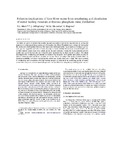Please use this identifier to cite or link to this item:
http://hdl.handle.net/10311/833| Title: | Pollution implications of Save River water from weathering and dissolution of metal hosting minerals at Dorowa phosphate mine, Zimbabwe |
| Authors: | Meck, M.L. Atlhopheng, J. Masamba, W.R.L. Ringrose, S. |
| Keywords: | Dorowa Phosphate Dissolution Weathering Metal pollution |
| Issue Date: | 20-Aug-2010 |
| Publisher: | Elsevier. http://www.elsevier.com |
| Citation: | Meck, M.L. et al (2010) Pollution implications of Save River water from weathering and dissolution of metal hosting minerals at Dorowa phosphate mine, Zimbabwe, Physics and Chemistry of the Earth, Vol.35, No. 13-14, pp. 679-685 |
| Abstract: | The study set out to determine the weathering and dissolution of metal hosting minerals at Dorowa for purposes of deducing pollution potential to the nearby Save River. Phosphate rock is mined at Dorowa for the production of phosphate fertilizer. The major minerals found in the ring complex are feldspars, pyroxenes, apatite, magnetite and calcite. Chemical analysis established that the rocks are associated with metals that include copper, lead, zinc, cobalt, nickel, tin and cadmium. Among the many minerals present apatite and calcite host metals more than the other minerals due to their crystal structure. This study investigated the weathering and dissolution of these two minerals. Both apatite and calcite dissolve in natural environmental conditions prevalent at Dorowa. From the analysis the study concludes that the potential availability of metals trapped in the calcite and apatite structures is high. The understanding of weathering and dissolution of metal hosting minerals is important in predicting quality of water around the study area, because most villagers use the Save River as their primary drinking water source. |
| URI: | http://hdl.handle.net/10311/833 |
| Appears in Collections: | Research articles (ORI) |
Files in This Item:
| File | Description | Size | Format | |
|---|---|---|---|---|
| Pollution implications of save river water from weathering and dissolution of metal hosting minerals at Dorowa phosphate mine, Zimbabwe.pdf | 814.86 kB | Adobe PDF |  View/Open |
Items in DSpace are protected by copyright, with all rights reserved, unless otherwise indicated.
